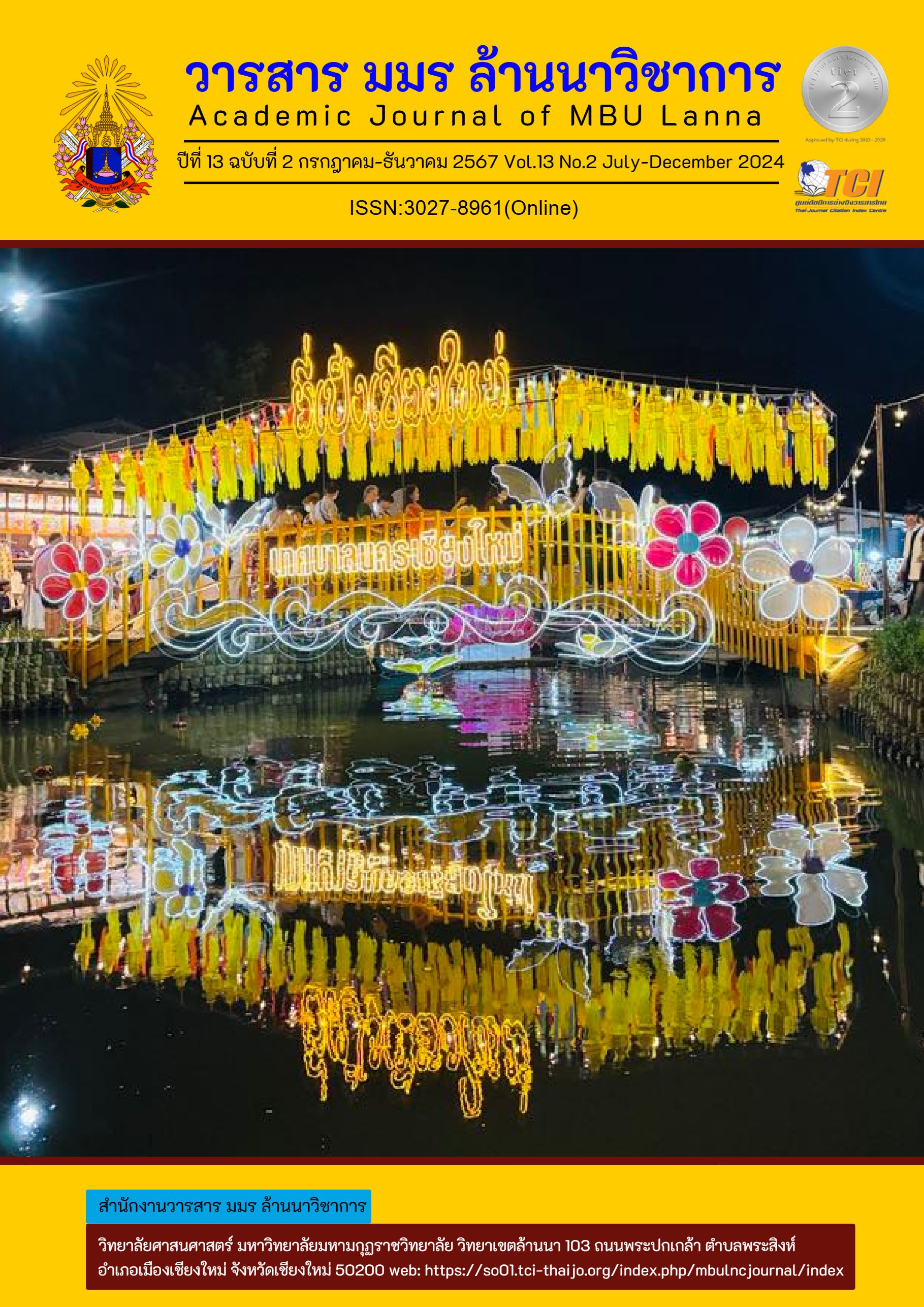A Program to Strengthen Creative Leadership of School Administrators under Kalasin Elementary Education Service Area Office 2
Keywords:
Program, Strengthen, Creative leadership, School administratorsAbstract
The objectives of this research were to: 1) study the current conditions, desirable conditions, and needs for enhancing creative leadership of school administrators 2) develop and validate a program to strengthen creative leadership 3) evaluate the suitability and usefulness of the program. The samples consisted of 113 school administrators, 7 experts, and 18 administrators and academic lead teachers. Research instruments included questionnaires, interview forms, and evaluation forms. Data was analyzed using basic statistics and content analysis.
The results of this research found that:
- The current conditions were at a high level, while the desirable conditions were at the highest level. The priority needs were creative thinking, cognitive flexibility, and vision creation.
- The developed program comprised principles, objectives, content in 3 modules, development methods, and evaluation. Its suitability and feasibility were at the highest level.
- The program's suitability and usefulness were evaluated to the highest level. Key findings revealed that creative leadership consists of 3 components, and the developed program can effectively enhance creative leadership of school administrators.
References
กิตติกร ธรรมกิจวัฒน์. (2562). การพัฒนาโปรแกรมเสริมสร้างภาวะผู้นำเชิงสร้างสรรค์ของผู้บริหารสถานศึกษาเอกชน สังกัดสำนักงานศึกษาธิการจังหวัดบุรีรัมย์ [วิทยานิพนธ์ปริญญามหาบัณฑิต ไม่ได้ตีพิมพ์]. มหาวิทยาลัยมหาสารคาม.
เกรียงไกร นามทองใบ. (2564). การพัฒนาโปรแกรมเสริมสร้างภาวะผู้นำเชิงสร้างสรรค์ของผู้บริหารสถานศึกษาสังกัดสำนักงานเขตพื้นที่การศึกษาประถมศึกษาศรีสะเกษ เขต 3 [วิทยานิพนธ์ปริญญามหาบัณฑิต ไม่ได้ตีพิมพ์]. มหาวิทยาลัยมหาสารคาม.
วิจารณ์ พานิช. (2556). วิถีสร้างการเรียนรู้เพื่อศิษย์ในศตวรรษที่ 21. มูลนิธิสดศรี-สฤษดิ์วงศ์.
สำนักงานเขตพื้นที่การศึกษาประถมศึกษากาฬสินธุ์ เขต 2. (2565). แผนพัฒนาการศึกษาขั้นพื้นฐาน พ.ศ. 2565-2567. สำนักงานเขตพื้นที่การศึกษาประถมศึกษากาฬสินธุ์ เขต 2.
สุภาพ ฤทธิ์บำรุง. (2556). ภาวะผู้นำเชิงสร้างสรรค์ของผู้บริหารสถานศึกษาที่ส่งผลต่อความมีประสิทธิผลของโรงเรียน สังกัดสำนักงานเขตพื้นที่การศึกษามัธยมศึกษา เขต 30 [วิทยานิพนธ์ปริญญามหาบัณฑิต ไม่ได้ตีพิมพ์]. มหาวิทยาลัยขอนแก่น.
สุรศักดิ์ ปาเฮ. (2556). การพัฒนาวิชาชีพครูสู่ยุคปฏิรูปการศึกษาในทศวรรษที่ 2. กรมส่งเสริมการปกครองท้องถิ่น. https://www.dla.go.th/upload/ebook/column/2012/7/1860_5273.pdf
อภิญญา โยธายุทธ. (2564). โปรแกรมเสริมสร้างภาวะผู้นำเชิงสร้างสรรค์ของผู้บริหารสถานศึกษา สังกัดสำนักงานเขตพื้นที่การศึกษามัธยมศึกษา เขต 32 [วิทยานิพนธ์ปริญญามหาบัณฑิต ไม่ได้ตีพิมพ์]. มหาวิทยาลัยมหาสารคาม.
Abdul, K. (2007). Creative leadership in the global knowledge economy. University of Cambridge.
Barr, M. J., & Keating, L. A. (1990). Introduction: Elements of program development. In M. J. Barr, M. L. Upcraft, & Associates (Eds.), New futures for student affairs: Building a vision for professional leadership and practice (pp. 1-20). Jossey-Bass.
Charney, D., & Conway, J. (2005). The strategic volunteer engagement: A guide for nonprofit and public sector leaders. Volunteer Canada.
Dunham, J., & Klafehn, K. A. (1990). Transformational leadership and the nurse executive. Journal of Nursing Administration, 20(4), 28-34.
Harris, A. (2009). Creative leadership: Developing future leaders. Management in Education, 23(1), 9-11. https://doi.org/10.1177/0892020608099076
Kanaya, T., Light, D., & Culp, K. M. (2005). Factors influencing outcomes from a technology focused professional development program. Journal of Research on Technology in Education, 37(3), 313-329. https://doi.org/10.1080/15391523.2005.10782439
Knowles, M. S., Holton III, E. F., & Swanson, R. A. (2015). The adult learner: The definitive classic in adult education and human resource development (8th ed.). Routledge.
Leithwood, K., Seashore Louis, K., Anderson, S., & Wahlstrom, K. (2004). How leadership influences student learning. The Wallace Foundation.
Mumford, M. D., Marks, M. A., Connelly, M. S., Zaccaro, S. J., & Reiter-Palmon, R. (2000). Development of leadership skills: Experience and timing. The Leadership Quarterly, 11(1), 87-114. https://doi.org/10.1016/S1048-9843(99)00044-2
Puccio, G. J., Mance, M., & Murdock, M. C. (2011). Creative leadership: Skills that drive change (2nd ed.). SAGE Publications.
Robinson, K. (2011). Out of our minds: Learning to be creative. Capstone Publishing.
Sisk, D. A. (2001). Creative leadership: A study of middle managers, senior level managers and CEOs. Gifted Education International, 15(3), 281-290. https://doi.org/10.1177/026142940101500306
Sternberg, R. J. (2006). The nature of creativity. Creativity Research Journal, 18(1), 87-98. https://doi.org/10.1007/978-1-4614-6616-1_383-2
Stoll, L., & Temperley, J. (2009). Creative leadership: A challenge of our times. School Leadership & Management, 29(1), 65-78. https://doi.org/10.1080/13632430802646404
Downloads
Published
How to Cite
Issue
Section
License
Copyright (c) 2024 Academic Journal of MBU Lanna

This work is licensed under a Creative Commons Attribution-NonCommercial-NoDerivatives 4.0 International License.
บทความที่ได้รับการตีพิมพ์เป็นลิขสิทธิ์ของวารสาร
ข้อความที่ปรากฏในบทความแต่ละเรื่องในวารสารเล่มนี้เป็นความคิดเห็นส่วนตัวของผู้เขียนแต่ละท่านหากมีความผิดพลาดใดๆ ผู้เขียนแต่ล่ะท่านจะรับผิดชอบบทความองตนเองแต่เพียงผู้เดียว


